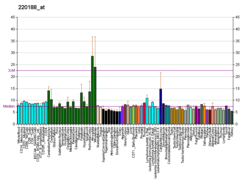JPH3
Junctophilin-3 is a protein that in humans is encoded by the JPH3 gene.[5][6][7]
Junctional complexes between the plasma membrane and endoplasmic/sarcoplasmic reticulum are a common feature of all excitable cell types and mediate cross talk between cell surface and intracellular ion channels. The protein encoded by this gene is a component of junctional complexes and is composed of a C-terminal hydrophobic segment spanning the endoplasmic/sarcoplasmic reticulum membrane and a remaining cytoplasmic domain that shows specific affinity for the plasma membrane. CAG/CTG repeat expansions at the Huntington's disease (HD)-like 2 locus have been identified in this gene, which is a member of the junctophilin gene family.[7]
References
- 1 2 3 GRCh38: Ensembl release 89: ENSG00000154118 - Ensembl, May 2017
- 1 2 3 GRCm38: Ensembl release 89: ENSMUSG00000025318 - Ensembl, May 2017
- ↑ "Human PubMed Reference:".
- ↑ "Mouse PubMed Reference:".
- ↑ Takeshima H, Komazaki S, Nishi M, Iino M, Kangawa K (Aug 2000). "Junctophilins: a novel family of junctional membrane complex proteins". Mol Cell. 6 (1): 11–22. doi:10.1016/S1097-2765(05)00005-5. PMID 10949023.
- ↑ Nishi M, Mizushima A, Nakagawara K, Takeshima H (Sep 2000). "Characterization of human junctophilin subtype genes". Biochem Biophys Res Commun. 273 (3): 920–7. doi:10.1006/bbrc.2000.3011. PMID 10891348.
- 1 2 "Entrez Gene: JPH3 junctophilin 3".
External links
Further reading
- Margolis RL, Abraham MR, Gatchell SB, et al. (1997). "cDNAs with long CAG trinucleotide repeats from human brain". Hum. Genet. 100 (1): 114–22. doi:10.1007/s004390050476. PMID 9225980.
- Olin KL, Potter-Perigo S, Barrett PH, et al. (2001). "Biglycan, a vascular proteoglycan, binds differently to HDL2 and HDL3: role of apoE". Arterioscler. Thromb. Vasc. Biol. 21 (1): 129–35. doi:10.1161/01.ATV.21.1.129. PMID 11145944.
- Holmes SE, O'Hearn E, Rosenblatt A, et al. (2001). "A repeat expansion in the gene encoding junctophilin-3 is associated with Huntington disease-like 2". Nat. Genet. 29 (4): 377–8. doi:10.1038/ng760. PMID 11694876.
- Stevanin G, Camuzat A, Holmes SE, et al. (2002). "CAG/CTG repeat expansions at the Huntington's disease-like 2 locus are rare in Huntington's disease patients". Neurology. 58 (6): 965–7. doi:10.1212/wnl.58.6.965. PMID 11914418.
- Strausberg RL, Feingold EA, Grouse LH, et al. (2003). "Generation and initial analysis of more than 15,000 full-length human and mouse cDNA sequences". Proc. Natl. Acad. Sci. U.S.A. 99 (26): 16899–903. doi:10.1073/pnas.242603899. PMC 139241. PMID 12477932.
- Ota T, Suzuki Y, Nishikawa T, et al. (2004). "Complete sequencing and characterization of 21,243 full-length human cDNAs". Nat. Genet. 36 (1): 40–5. doi:10.1038/ng1285. PMID 14702039.
- Gerhard DS, Wagner L, Feingold EA, et al. (2004). "The status, quality, and expansion of the NIH full-length cDNA project: the Mammalian Gene Collection (MGC)". Genome Res. 14 (10B): 2121–7. doi:10.1101/gr.2596504. PMC 528928. PMID 15489334.
- Grimsby S, Jaensson H, Dubrovska A, et al. (2005). "Proteomics-based identification of proteins interacting with Smad3: SREBP-2 forms a complex with Smad3 and inhibits its transcriptional activity". FEBS Lett. 577 (1–2): 93–100. doi:10.1016/j.febslet.2004.09.069. PMID 15527767.
- Ewing RM, Chu P, Elisma F, et al. (2007). "Large-scale mapping of human protein-protein interactions by mass spectrometry". Mol. Syst. Biol. 3 (1): 89. doi:10.1038/msb4100134. PMC 1847948. PMID 17353931.
This article is issued from
Wikipedia.
The text is licensed under Creative Commons - Attribution - Sharealike.
Additional terms may apply for the media files.




